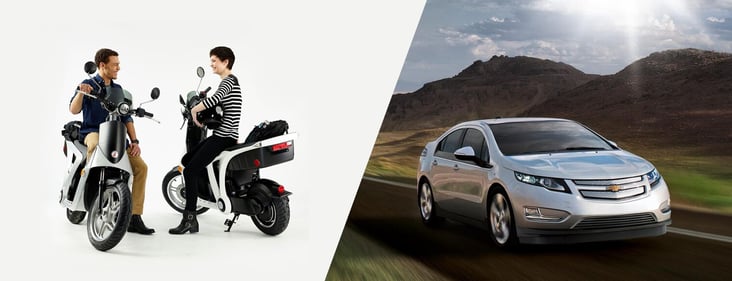This post is one in a series featuring the complete slate of advanced energy technologies outlined in the report This Is Advanced Energy.

Image courtesy of GenZe and Chevrolet.
Plug-in electric vehicles (PEVs) are emerging as an important vehicle platform in the United States and globally. PEVs are powered completely or in part by batteries (typically lithium-ion) that can be recharged with power from the electric grid. PEVs include 100% battery electric vehicles (BEVs) such as the Nissan Leaf and Tesla Model S, and plug-in hybrid electric vehicles (PHEVs) such as the Chevy Volt and Toyota Prius Plug-in, which contain both a battery and a gasoline-powered engine. BEVs typically have ranges of about 80 to 250 miles, while PHEVs have electric-only ranges of about 20 to 40 miles, after which they operate on gasoline, giving them a driving range equivalent to any gasoline-powered vehicle. As with hybrid electric vehicles (p.57), all PEVs take advantage of regenerative braking to extend electric range.
Although sales of PEVs are relatively small, the market is growing. U.S. sales were just under 120,000 units in 2014, or about 0.7% of total vehicle sales, up from approximately 96,000 in 2013. These sales represent signi cant market growth, with U.S. revenue jumping from $700 million to $4.8 billion between 2011 and 2014, including a 34% increase between 2013 and 2014 alone. The United States remains the leading country for PEV sales, with an estimated 39% of the global market share.
The upfront cost of PEVs is higher than traditional vehicles, with battery cost the main driver of the higher purchase price. As battery costs decline and manufacturing scales up, vehicle costs are expected to fall. Higher upfront costs are offset by the very high ef ciency of electric drivetrains, which can achieve gasoline-equivalent fuel economy in excess of 100 mpg. Both PHEVs and BEVs provide economic benefits from fuel cost savings, with BEVs also offering reduced maintenance costs resulting from the overall simplicity of an all-electric drive train. In addition, electric drive trains are smoother and quieter, and provide faster acceleration than conventional mechanical drive trains.
As PEV markets grow, consideration must be given to the impacts of vehicle charging on the electricity grid. Smart integration of vehicle charging with the grid can avoid capacity shortfalls and save customers money by facilitating charging with lower-cost off-peak power. With eventual full, bi-directional integration with the grid, PEVs can also be used for energy storage, providing grid support functions such as peak shaving, load shape smoothing, renewables integration, and power quality services. As the size of the PEV fleet grows, the ability to aggregate and manage vehicles in a coordinated fashion has the potential to amplify these benefits. Using PEV batteries as storage for grid support is currently in deployment in a number of pilot projects around the country, including work by the U.S. Army and the National Renewable Energy Laboratory at Fort Carson, Colorado, and by the University of Maryland in partnership with NRG and BMW.
Learn more about advanced vehicles and the entire advanced energy economy in AEE's report This Is Advanced Energy, available for free at the link below:
